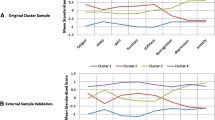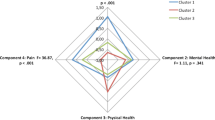Abstract
The main goal of this project was to identify the presence of fibromyalgia (FM) subgroups using a simple and frequently used clinical tool, the Fibromyalgia Impact Questionnaire (FIQ). A total of 61 women diagnosed with FM participated in this study. FM subgroups were created by applying a hierarchical cluster analysis on selected items of the FIQ (pain, fatigue, morning tiredness, stiffness, anxiety and depressive symptoms). We also tested for group differences on experimental pain, psychosocial functioning and demographic characteristics. Two cluster profiles best fit our data. FM-Type I was characterized by the lowest levels of anxiety, depressive and morning tiredness symptoms, while FM-Type II was characterized by elevated levels of pain, fatigue, morning tiredness, stiffness, anxiety and depressive symptoms. Both FM subgroups showed hyperalgesic responses to experimental pain. These results suggest that pain and stiffness are universal symptoms of the disorder but that psychological distress is a feature present only in some patients.

Similar content being viewed by others
References
Wolfe F, Smythe HA, Yunus MB et al (1990) The American College of Rheumatology 1990 Criteria for the Classification of Fibromyalgia Report of the Multicenter Criteria Committee. Arthritis Rheum 33:160–172
Burckhardt CS, Clark SR, Bennett RM (1991) The Fibromyalgia Impact Questionnaire: development and validation. J Rheumatol 18:728–733
Turk DC, Okifuji A, Sinclair JD, Starz TW (1996) Pain, disability, and physical functioning in subgroups of patients with fibromyalgia. J Rheumatol 23:1255–1262
Turk DC, Okifuji A, Sinclair JD, Starz TW (1998) Differential responses by psychosocial subgroups of fibromyalgia syndrome patients to an interdisciplinary treatment. Arthritis Care Res 11:397–404
Giesecke T, Williams DA, Harris RE et al (2003) Subgrouping of fibromyalgia patients on the basis of pressure-pain thresholds and psychological factors. Arthritis Rheum 48:2916–2922
Naschitz JE, Rozenbaum M, Rosner I et al (2001) Cardiovascular response to upright tilt in fibromyalgia differs from that in chronic fatigue syndrome. J Rheumatol 28:1356–1360
Graven-Nielsen T, Aspegren KS, Henriksson KG et al (2000) Ketamine reduces muscle pain, temporal summation, and referred pain in fibromyalgia patients. Pain 85:483–491
Hurtig IM, Raak RI, Kendall SA, Gerdle B, Wahren LK (2001) Quantitative sensory testing in fibromyalgia patients and in healthy subjects: Identification of subgroups. Clin J Pain 17:316–322
Turk DC (2005) The potential of treatment matching for subgroups of patients with chronic pain: lumping versus splitting. Clin J Pain 21:44–55
Muller W, Schneider EM, Stratz T (2007) The classification of fibromyalgia syndrome. Rheumatol Int 27:1005–1010
Robinson ME, Brown JL, George SZ et al (2005) Multidimensional success criteria and expectations for treatment of chronic pain: the patient perspective. Pain Med 6:336–345
Raak R, Hurtig I, Wahren LK (2003) Coping strategies and life satisfaction in subgrouped fibromyalgia patients. Biol Res Nurs 4:193–202
Hamilton NA, Karoly P, Zautra AJ (2005) Health goal cognition and adjustment in women with fibromyalgia. J Behav Med 28:1–12
Marques AP, Ferreira EA, Matsutani LA, Pereira CA, Assumpcao A (2005) Quantifying pain threshold and quality of life of fibromyalgia patients. Clin Rheumatol 24:266–271
Perrot S, Dumont D, Guillemin F, Pouchot J, Coste J (2003) Quality of life in women with fibromyalgia syndrome: validation of the QIF, the French version of the Fibromyalgia Impact Questionnaire. J Rheumatol 30:1054–1059
Kerns RD, Turk DC, Rudy TE (1985) The west Haven-Yale multidimensional pain inventory (WHYMPI). Pain 23:345–356
Laliberté S, Sullivan MJL, Charron JLJ, Bouthiller D, Miller J-M, Tremblay I (2005) Du Multidimensional Pain Inventory à l’inventaire multidimensionnel de la douleur : traduction et validation. Canadian Pain Society Meeting (abstract)
Ware JE Jr (2000) SF-36 health survey update. Spine 25:3130–3139
Leplege A, Ecosse E, Verdier A, Perneger TV (1998) The French SF-36 Health Survey: translation, cultural adaptation and preliminary psychometric evaluation. J Clin Epidemiol 51:1013–1023
Sullivan MJL, Bishop S, Pivik J (1995) The pain catastrophizing scale: development and validation. Psychol Assess 7:524–532
French DJ, Noel M, Vigneau F, French JA, Cyr CP, Evans RT (2005) L’Échelle de dramatisation face à la douleur PCS-CF Adaptation canadienne en langue française de l’échelle «Pain Catastrophizing Scale». Revue canadienne des sciences du comportement 37:181–192
Marchand S, Arsenault P (2002) Spatial summation for pain perception: interaction of inhibitory and excitatory mechanisms. Pain 95:201–206
Marchand S, Charest J, Li J, Chenard JR, Lavignolle B, Laurencelle L (1993) Is TENS purely a placebo effect? A controlled study on chronic low back pain. Pain 54:99–106
Aldenderfer MS, Blashfield RK (1984) Cluster analysis. Sage Press, Beverly Hills
Milligan GW, Cooper MC (1985) An examination of procedures for determining the number of clusters in a data set. Psychometrika 50:159–179
Kosek E, Ekholm J, Hansson P (1996) Sensory dysfunction in fibromyalgia patients with implications for pathogenic mechanisms. Pain 68:375–383
Julien N, Goffaux P, Arsenault P, Marchand S (2005) Widespread pain in fibromyalgia is related to a deficit of endogenous pain inhibition. Pain 114:295–302
Lowe B, Grafe K, Ufer C et al (2004) Anxiety and depression in patients with pulmonary hypertension. Psychosom Med 66:831–836
Barth J, Schumacher M, Herrmann-Lingen C (2004) Depression as a risk factor for mortality in patients with coronary heart disease: a meta-analysis. Psychosom Med 66:802–813
Maddigan SL, Feeny DH, Majumdar SR, Farris KB, Johnson JA (2006) Understanding the determinants of health for people with type 2 diabetes. Am J Public Health 96:1649–1655
Acknowledgments
This research was supported by Dr. Marchand’s research grants from the Canadian Institutes of Health Research (CIHR), the FRSQ Centre de recherche clinique Étienne-Le Bel du CHUS and by a postgraduate scholarship from the Coordenadoria de Aperfeicoamento de Pessoal do Ensino Superior (CAPES, subordinate to the Brazilian Ministry of Education and Culture) given to Juliana Barcellos de Souza. We thank Paule Julien and Stéphanie Pagé for providing excellent technical assistance and our participants for volunteering in this study.
Author information
Authors and Affiliations
Corresponding author
Rights and permissions
About this article
Cite this article
de Souza, J.B., Goffaux, P., Julien, N. et al. Fibromyalgia subgroups: profiling distinct subgroups using the Fibromyalgia Impact Questionnaire. A preliminary study. Rheumatol Int 29, 509–515 (2009). https://doi.org/10.1007/s00296-008-0722-5
Received:
Accepted:
Published:
Issue Date:
DOI: https://doi.org/10.1007/s00296-008-0722-5




